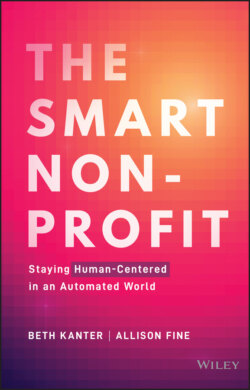Читать книгу The Smart Nonprofit - Beth Kanter - Страница 7
PREFACE
ОглавлениеFor the last four years, we have been tracking the use of digital technologies like artificial intelligence, what we call “smart tech” in this book, for social good. Smart tech is very quickly becoming embedded in nonprofit operations. It is helping them automate tasks such as screening clients for services, filling out expense reports, and identifying prospective donors. Sometimes organizations are intentionally choosing to add smart tech to their efforts, but more often we are finding that smart tech is sneaking into organizations without organizations realizing it.
This moment feels familiar. We have been writing about the wide scale adoption of social media since the early 2000s. We know the patterns of technology adoption: there are small commercial vendors with funny names overhyping the benefits and underplaying the risks, there are a few early adopters finding clever ways to use the technology, and there is the enormous ecosystem of nonprofits and foundations who are resistant to change and technology.
We believed smart tech was part of the ongoing march of technology that makes organizations go faster and become more efficient until we had a talk with our friend Steve MacLaughlin, vice president of product management at Blackbaud. He told us during a podcast interview in October 2020 that the benefit of using smart tech isn't about increasing speed and scale; it's about time.
Smart tech is going to take over time-consuming rote tasks that are taking hours to do right now, freeing up enormous amounts of staff time. Steve calls this the “AI dividend.” We call it the “dividend of time” in this book. Whatever you call it, the idea is profound and potentially revolutionary.
The choices organizations make about how to use their dividend of time is the key to the next stage in organizational life. We can choose to continue our frantic pace of work, responding to crises and flooding inboxes with email solicitations. Or we can choose to use this new time to reduce staff burnout, get to know clients on a deeper, human level, and focus on solving problems like homelessness in addition to serving homeless people. And as far-fetched as it may seem, we believe nonprofits can use this time to become the leaders in the ethical and responsible use of smart tech, the most powerful technology everyday people and organizations have ever used. Taken altogether, this is the essence of being a smart nonprofit.
We have a once-in-a-generation opportunity to remake work but only for those people and organizations that are thoughtful and knowledgeable about the use of smart tech. It also raises existential questions such as: When should machines do the work people do now? How can we be actively anti-biased using smart tech? What can we do differently or better with our new time? We hope this book gives you and your colleagues a solid foundation for understanding and answering these kinds of questions.
We hope the increased dividend of time will be spent doing the things that only people can do: building strong relationships, dreaming up new solutions, creating and strengthening communities. We want to turn the page on our era of frantic busyness and scarcity to one in which smart nonprofits have the time to think and plan and even dream.
